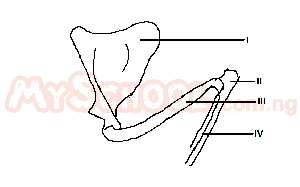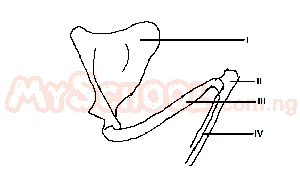Year :
1999
Title :
Biology
Exam :
JAMB Exam
Paper 1 | Objectives
31 - 40 of 50 Questions
| # | Question | Ans |
|---|---|---|
| 31. |
Th chitin in the exoskeleton of many arthropods is strengthened by A. calcium compounds B. organic salts C. lipids D. proteins |
A |
| 32. |
 The structure labelled II articulates with III to form A. sliding joint B. hinge joint C. pivot joint D. ball-and-socket joint |
B |
| 33. |
 Which of the bones is the radius? A. I B. II C. III D. IV |
D |
| 34. |
The construction of dams may lead to an increase in the prevalence of A. typhoid fever, measles and yellow fever B. tuberculosis, leprosy and trypanosomiasis C. guinea worm, malaria and tuberculosis D. malaria, bilharziasis and onchocerciasis |
D |
| 35. |
Floating microscopic heterotrophs are mostly grouped as A. phytoplankton B. zooplankton C. microbes D. nekton |
B |
| 36. |
Vaccination is carried out in order to A. check the production of poison B. increase the activity of white blood cells C. increase the number of red blood cells D. stimulate the production of antibodies |
D |
| 37. |
A soil consisting of alumina and iron (II)oxide is known as A. loamy soil B. clayey soil C. laterite D. podzol |
C |
| 38. |
The sign + is used to indicate an association where an organism gains, while 0 is used where an organism is unaffected. An association indicated as +0 is known as A. predation B. commensalism C. parasitism D. competition |
B |
| 39. |
Which of the following characterizes the white mangrove? A. Prop roots B. Buttress roots C. Breathing roots D. Stilt roots |
C |
| 40. |
If the offspring of a cross between a brown mouse (bb) and a black mouse (BB) are allowed to interbreed, how many different genotypes would result? A. 2 B. 3 C. 4 D. 5 |
B |
| 31. |
Th chitin in the exoskeleton of many arthropods is strengthened by A. calcium compounds B. organic salts C. lipids D. proteins |
A |
| 32. |
 The structure labelled II articulates with III to form A. sliding joint B. hinge joint C. pivot joint D. ball-and-socket joint |
B |
| 33. |
 Which of the bones is the radius? A. I B. II C. III D. IV |
D |
| 34. |
The construction of dams may lead to an increase in the prevalence of A. typhoid fever, measles and yellow fever B. tuberculosis, leprosy and trypanosomiasis C. guinea worm, malaria and tuberculosis D. malaria, bilharziasis and onchocerciasis |
D |
| 35. |
Floating microscopic heterotrophs are mostly grouped as A. phytoplankton B. zooplankton C. microbes D. nekton |
B |
| 36. |
Vaccination is carried out in order to A. check the production of poison B. increase the activity of white blood cells C. increase the number of red blood cells D. stimulate the production of antibodies |
D |
| 37. |
A soil consisting of alumina and iron (II)oxide is known as A. loamy soil B. clayey soil C. laterite D. podzol |
C |
| 38. |
The sign + is used to indicate an association where an organism gains, while 0 is used where an organism is unaffected. An association indicated as +0 is known as A. predation B. commensalism C. parasitism D. competition |
B |
| 39. |
Which of the following characterizes the white mangrove? A. Prop roots B. Buttress roots C. Breathing roots D. Stilt roots |
C |
| 40. |
If the offspring of a cross between a brown mouse (bb) and a black mouse (BB) are allowed to interbreed, how many different genotypes would result? A. 2 B. 3 C. 4 D. 5 |
B |